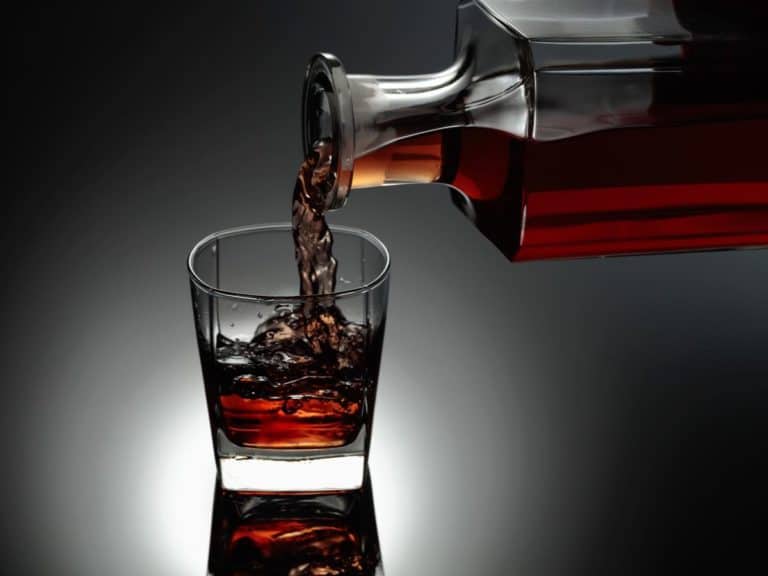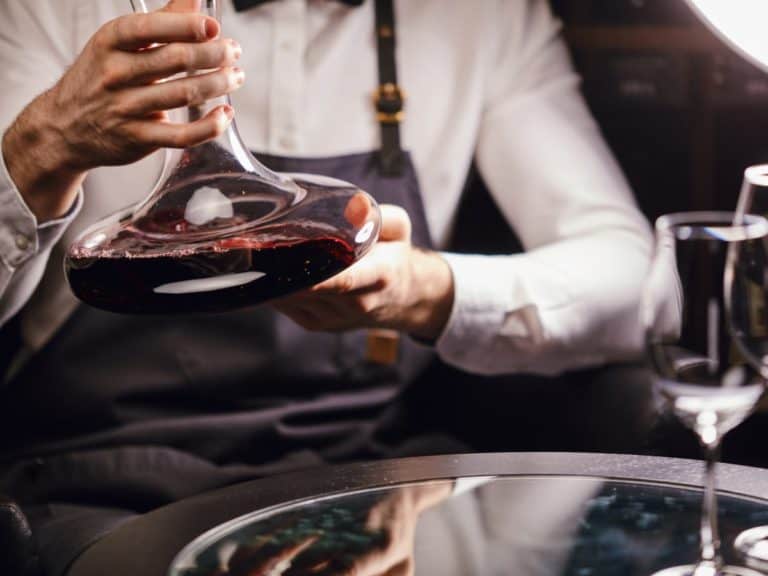Do You Aerate Rose or White Wines?
Many wine drinkers know that several red varieties of wine need aeration. However, did you know that rose and white wines need aeration, too? Aeration is a simple technique of wine preparation that can benefit many different wine varieties.
Nose-centric rose wines and dry, full-bodied white wines must be aerated for up to an hour before serving. Aeration of rose and white wines should be done while keeping their temperature as chilled as possible. Aeration is performed to release excess tannins and improve the wine’s aroma.
So what exactly is aeration, and how is it performed? Keep reading to learn more about why certain wines are aerated before serving and how it affects their flavor.
What Is Aerating Wine?
Aerating wine slightly ages wine by exposing it to air for ten to thirty minutes before drinking it.

Here are a few of the benefits of aerating your wine before drinking it:
- Improves finish: Wines with a high level of tannins will have a dry, almost leathery finish. Aerating these wines gives them a smoother finish and makes them more palatable.
- Improves aroma: Aerating wine encourages wine to release its aromas, making this process beneficial for wines with a strong or distinctive scent.
- Releases sulfites: Sulfites are chemicals in the wine that can have a slight aroma of burnt matches or rotten eggs, which may give unaerated wine an off scent or flavor. Aeration allows these sulfites to disperse.
- Releases alcohol smells: When you open a bottle of wine, the built-up aroma of the alcohol in the wine can have a sharp or medicinal smell. Letting the wine breathe a little allows these odors to dissipate, leaving only the wine’s fruit, spice, and floral notes underneath.
As you can see, there are many reasons why it’s a good idea to consider whether or not the variety of wine you’re serving needs to be aerated. For wines that benefit from aeration, skipping this step can negatively impact their flavor and aroma.
What Does Wine Aeration Do?
The core process involved in wine aeration is a process called oxidation. Once a wine bottle is uncorked and poured, agitated wine is exposed to oxygen. Some oxidation occurs naturally during the wine-making process, but most oxidation is avoided until right before serving.
While some oxidation can help bring out the best flavors and aromas in your wine, too much oxidation leads to an effect on the wine called flattening. Flattened wine will have a much more muddled and unsatisfying flavor compared to the way it’s supposed to taste when it’s fresh.
The molecules in wine that change flavor in response to oxidation are also responsible for the wine’s pigment. In general, this means that the darker the wine is, the more likely it will need to be aerated before serving to get the best flavor out of it.
Related Article: How Long Does Port Last in a Decanter?
Aerating vs. Decanting
Many wine novices may get the terms aerating and decanting mixed up. In wine, aeration is the process of exposing a bottled wine to oxygen after it’s been opened. Decanting is the term for moving a bottle of wine from the bottle to a decanter. A decanter is a wide-mouthed carafe used specifically for aerating wines.
Related Article: How to Decant Wine Without a Decanter
What Does It Mean to Decant Wine?
In serving wine, decanting isn’t just responsible for aerating the wine. Decanting is also a method to remove sediment from the wine. While sediment won’t hurt anyone who drinks it, it does ruin the look of the wine.
You should slowly pour the wine from the bottle into the decanter when decanting wine.
This allows the wine to mix thoroughly with oxygen in the air and gives you plenty of warning to avoid adding sediment to your wine decanter. You can also quit pouring before the final inch or two of wine in the bottle to prevent taking up any sediment while decanting and aerating wine.
Does Aerating Wine Make It Taste Better?
For nose-heavy wines or wines that contain a lot of red pigment, such as ports and reds, aerating the wine makes it taste and smell much better than it would if you skipped aeration. Some dry rose and white wines also benefit from aeration if you let them breathe before drinking them.
Why Does Aerating Wine Make It Taste Better?
Aerating wine works in two major ways to make wine taste better – it reduces some elements of the wine, such as alcohol odors and sulfites, while it increases other elements, such as the wine’s aroma.
Here are the main reasons that aerating wine makes it taste better (Source: Bright Cellars):
- Increases wine expression: Wine can carry many different flavor and aroma notes. Aerating wine brings out flavors and aromas in wine that would be suppressed otherwise.
- Reduces tannins: The biggest favor that aeration does for wine’s flavor is to reduce the impact of tannins on the wine’s flavor and aroma. The younger wine is, the more likely it is to contain these tannins, which is one of the reasons aged wine is so highly prized.
If you aerate wine in a decanter, another more psychological reason that your wine will taste better is presentation. Decanters allow the beauty of the wine to be on display without being obscured by a bottle label, and this lets drinkers appreciate its beautiful color and body.
How Do You Aerate Wine?
The key to aerating wine properly is to expose as much of the wine to oxygen as possible.
Many people perform a soft decanting by uncorking their wine bottle and allowing it to “breathe” for several minutes before serving. However, this decanting method isn’t suitable for reds or any wine that needs significant aeration since the wine at the bottom of the bottle doesn’t get exposed to oxygen.
The best way to aerate wine is to perform a hard decanting. This involves pouring the wine in the wine bottle slowly into a decanter, allowing the wine to become thoroughly mixed with oxygen in the air before allowing it to settle in the decanter for several hours. (Source: Cook’s Illustrated)
If the wine should be chilled before serving, such as a white or rose wine, the decanter can be placed in a wine chiller until the time comes to serve it.
Should Rose Wine Be Aerated?
Whether or not a rose wine should be aerated depends on the flavor profile of the wine. Generally speaking, rose wines are not aerated because they have a delicate aroma. Most of these wines are also chilled, further softening their aroma and flavor. This soft, mellow profile means that many rose wines don’t require aeration to be at their best for serving.
However, because rose wine does contain the pigment molecules that are softened by aeration, it does beefit from being aerated at least a little before serving. Usually just fifteen to thirty minutes of aeration can bring out a rose wine’s flavor beautifully as long as it remains chilled during the process.
A good rule of thumb to follow with aerating rose wine is that the darker in color the rose wine is, the more likely it will need a little aeration before serving. Blush wines with only a hint of color will need much less aeration since they don’t have a large amount of tannins.
Related Article: How to Buy Rosé Wine
Should White Wine Be Aerated?
It isn’t usually considered necessary to aerate white wines in the same way it’s considered necessary to aerate reds, but very young white wines can benefit from aeration before serving. While aeration doesn’t impact the flavor as much with white wines, it can help the white wine develop a more expressive aroma.
When it comes to white wine, there are certain types of white wine that benefit more from an aeration period than others. The white wines that benefit from aeration tend to be dry, full-bodied, and with a heavy mouthfeel.
These include varieties such as the following:
- White Burgundy
- White Bordeaux
- Corton-Charlemagne
- Alsace
White wines don’t typically need to be aerated beyond thirty minutes. It’s also important that white wines remain chilled before serving, so aerating them in a wine chiller is best.
Which Rose and White Wines Should Not Be Aerated?
There are really no types of wine that would be ruined by aeration as long as the wine wasn’t left exposed to oxygen indefinitely. All rose and white wines can be aerated without hurting them if you keep aeration times to an hour or less.
Decanters for Aerating Rose and White Wine
Decanters are one of the most popular methods for aerating wines since they allow wine enthusiasts to show off their wine at the same time that they’re aerating it. Wine decanters are a popular addition to a formally-set dining table since the wine can be set out at the table with the rest of the silverware and allowed to rest while guests are greeted.
Most wine decanters are made from translucent glass or lead crystal since this allows the wine to be displayed through them. However, pewter decanters can also be found. Wine decanters are usually designed to hold an entire standard-sized bottle of wine (750 milliters).
Types of Decanters
Decanters come in several different shapes that are designed to achieve different effects during aeration. Here are some of the most common types of wine decanters you’ll find when you’re looking for a container to aerate your wine in:
- Standard decanters: Standard decanters have a flared, wide-necked opening and a short, wide base. A variation of the standard decanter includes an angled neck that makes pouring wine from the decanter into wine glasses easier.
- Swan wine decanter: Swan wine decanters are typically created from hand-blown glass or crystal and have a U-shaped base with one narrow opening and one wide-mouthed opening. In this decanter design, the wide opening is used to load the decanter with wine from the bottle, while the narrow opening is used as a spout for serving.
- Snail-shaped wine decanter: Snail-shaped wine decanters are similar to standard decanters except they form a loop shape at the base with an opening that acts as the decanter’s handle. This gives the snail-shaped wine decanter an easy grip when it’s time to serve.
- Wine decanter with built-in strainer: Wine decanters with built-in strainers are the favored variety to use with wines that contain a lot of sediment, such as aged wines. The strainer prevents the sediment in the wine bottle from ending up in the wine glasses.
The type of wine decanter you choose is largely a matter of personal preference. While a decanter with a built-in punt at the base or a strainer will be useful for wines that contain a lot of sediment, any decanter should be helpful when it comes to aerating your wine.
Best Decanters for Aerating Wine
When you’re looking for a wine decanter, it’s a good idea to check out decanters that are well-reviewed and have a good reputation. You’ll usually only have one decanter out on your dining room table at a time, so you’ll want it to act as a statement piece for your home and as a practical tool for improving your wine.

Here are some of the best wine decanters you can choose from to get started aerating your rose and white wines:
- Le Chateau Wine Decanter: If you’re looking for a standard-shaped and basic wine decanter to decorate your table, look no further than the Le Chateau (Amazon). This decanter has an extra-wide base to maximize aeration so you don’t have to wait too long to drink.
- Nutriups Snail Wine Decanter: This snail wine decanter from Nutriups is made of hand-blown crystal for brightness and durability. This is a smaller decanter that is only designed to hold half a bottle of wine to serve one or two people, so it’s perfect for small households.
- Chateau la Derive Swan Decanter: The swan decanter from Chateau la Derive is unique because it has an iridescent finish. This decanter also comes with a vacuum stopping system that prevents the wine from going flat after aeration.
These are only a few of the decanters available online that you can buy to aerate your wine. Whether you want a small decanter for solo wine sessions or you want one that can hold a full bottle for a dinner party, a beautiful wine decanter can go a long way towards setting the mood for your next social gathering.
Aerating Rose and White Wines Is Worth the Wait
You might feel impatient having to wait up to an hour to drink your wine after uncorking it, but this is definitely one situation where patience is a virtue. Allowing your white and rose wines to aerate properly before serving can provide you with a much smoother, more flavorful drinking experience.
Read Also: Is Rosé Wine or Champagne?





